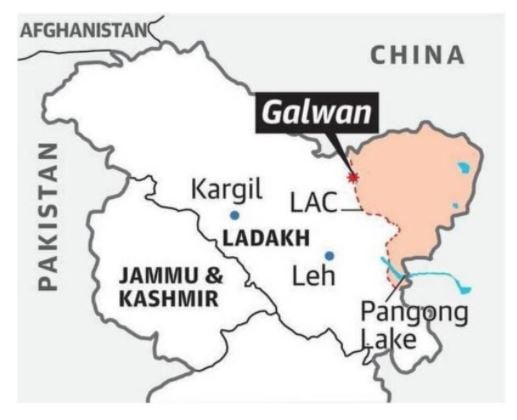The Big Picture- RSTV, UPSC Articles
U.S. Report on Galwan
Archives
Topic: General Studies 2,3:
- India and its neighborhood- relations
- Challenges in managing the borders
In News: A report was tabled in the US Congress that claims that the Chinese government planned the Galwan incident, where 20 Indian soldiers laid down their lives fighting the Chinese troops.
The Report
In its just-released annual report, the United States-China Economic and Security Review Commission says that Beijing scaled up a “coercion campaign” against India. The report says that while the exact reasons for China’s motivation to provoke India on the Line of actual control (LAC) is unclear, the proximate cause of the clash appears to be to harm India’s strategic and economic interests.
China has ramped up its “multi-year coercion campaign” against its neighbours, provoking military or paramilitary standoffs with countries — from Japan to India and much of Southeast Asia. The June clash was the first confrontation since 1975 that resulted in loss of lives on either side. It said the CCP employs its armed forces as a coercive tool during peacetime, carrying out large-scale intimidation exercises around Taiwan and in the South China Sea.
The report also noted that just over two weeks before the incident, “in another potential indication of Chinese leaders signaling their intent to escalate tensions”, an editorial in China’s state-owned tabloid Global Times warned that India would suffer a “devastating blow” to its trade and economic ties with China if it got “involved in the US-China rivalry”. It said that China and India have engaged in multiple physical clashes along their border for decades, but “since General Secretary Xi assumed power in 2012, the two countries have seen five major altercations”.
Talking about the Chinese move of bringing 7.5 million residents of Hong Kong under full and direct authoritarian rule with the implementation of a draconian national security law passed in Beijing, the top Congress panel said “this action was one of many in 2020” that demonstrated the Chinese government’s indifference to its reputation abroad.
The other Chinese actions mentioned in the report were border skirmishes with India, military exercises to intimidate Taiwan, and pressure on Australia, Canada, and the United Kingdom, among others.
It said that while earlier China always spoke about maintaining strategic relations with India and Japan, since General Secretary Xi Jinping’s ascent to power, China has steadily increased military pressure on both countries, leading to a significant deterioration in Sino-Japanese and Sino-Indian ties.
What should India do?
Apart from insisting on a timely and early clarification of the LAC, India should take a long view of its South Asia policy.
- Strong political direction, mature deliberation and coherence are keys to handling the situation.
- The Army can make tactical adjustments and manoeuvres to deter the Chinese
- Also, a comprehensive China strategy must be evolved along with effective strategic communication from top level
- Be proactive: India that should take the initiative to insist on a timely and early clarification of the LAC.
- Temporary resolutions: Pockets of difference of alignment as perceived by each side have to be clearly identified and these areas demilitarised by both sides through joint agreement pending a settlement of the boundary
- Realignment of Foreign Policy
- The events in Galwan Valley should be a wake-up call to many of India’s Asian friends and partners about Chinese aggressiveness
- This is also an opportunity for India to align its interests much more strongly and unequivocally with the U.S. as a principal strategic partner and infuse more energy into its relations with Japan, Australia, and the ASEAN
Prelims oriented Notes
Where is Galwan Valley?
- The valley refers to the land that sits between steep mountains that buffet the Galwan River.
- The river has its source in Aksai Chin, on China’s side of the LAC, and it flows from the east to Ladakh, where it meets the Shyok river on India’s side of the LAC.
- The valley is strategically located between Ladakh in the west and Aksai Chin in the east (currently controlled by China)
- At its western end are the Shyok river and the Darbuk-Shyok-Daulet Beg Oldie (DSDBO) road.
- Its eastern mouth lies not far from China’s vital Xinjiang Tibet road, now called the G219 highway.

Source: The Hindu
Connecting the Dots :
- What are your views on the recent military standoff between India and China? What is the geo-strategic background of the standoff? Examine.











